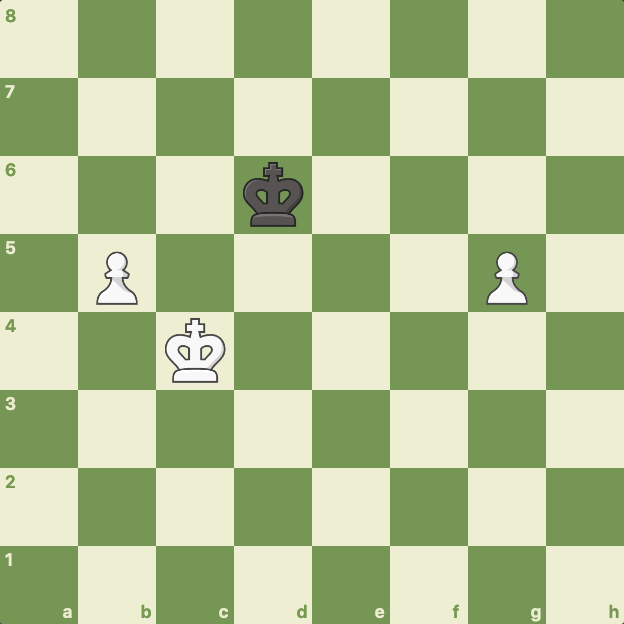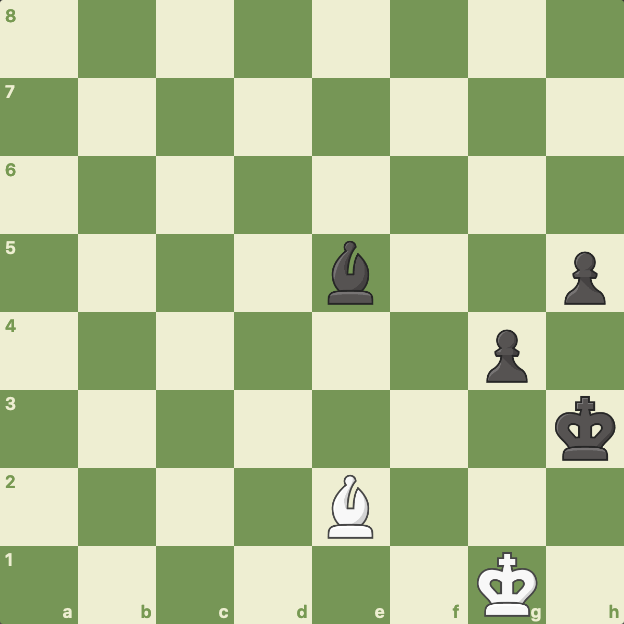
Chess Endgame
A normal game of chess has three stages: opening, middlegame, and endgame. The average advanced chess player usually spends a lot of time on their openings and middlegames, but rarely gives much attention to the equally important endgame phase! Let's learn what the endgame is and why it is important.
What Is A Chess Endgame?
The endgame in chess is the phase of the game that occurs after most of the pieces have been exchanged—the stage of the game that happens at the end. Not every game of chess reaches the endgame, as some games are decided in the middlegame (or even by early checkmates in the opening). However, most games do reach the endgame stage.
In general, endgames have different strategic goals than other phases. One main goal in the opening is to develop your pieces, while in the middlegame your goal could be to attack an enemy king or to protect your own king—but in the endgame, one of the main goals is to try and promote a pawn.
Let's take a look at a king-and-pawn endgame example:

As you can see, the white king is supporting the passed b5-pawn, while the black king must make a choice regarding which passed pawn to try and stop. Even though White is up two pawns, the engine evaluation is not +2.0—this position is actually evaluated as +61.0. This is because no matter which pawn the black king commits to, White will simply promote the other pawn.
The king becomes a powerful piece in the endgame. The fewer pieces your opponent has, the less danger your own king can be in! In endgames, a king is often brought to the center of the board or moved forward to support a passed pawn. Each pawn's value also increases in the endgame, as both sides attempt to promote pawns into queens. As former world champion Jose Raul Capablanca said, "A passed pawn increases in strength as the number of pieces on the board diminishes."
A passed pawn increases in strength as the number of pieces on the board diminishes.
— Jose Raul Capablanca
Another important idea to keep in mind relating to endgames is that the side with a material advantage generally wants to exchange material, while the side that is down material should try to avoid piece exchanges (as they only serve the side with more material).
Why Is The Endgame Important?
Learning endgames is important because it drastically improves your winning chances. Unlike opening theory (which changes often), endgame theory and knowledge are not subject to much change. Many endgame principles and techniques, like Philidor’s famous rook-and-pawn endgame, have stood the test of time and will continue to do so. By learning solid endgame play, you are setting yourself up for long-term success!
Strong endgame players can convert the tiniest advantages as well as save bad endgames that should probably be lost. Attaining this power is not easy, but once learned the rewards add up in the form of extra half-points from winning theoretically drawn positions or drawing tough positions down a pawn (or more). As GM Edmar Mednis stated, "The amount of points that can be gained (and saved) by correct endgame play is enormous, yet often underestimated by youngsters and amateurs."
The amount of points that can be gained (and saved) by correct endgame play is enormous, yet often underestimated by youngsters and amateurs.
— GM Edmar Mednis
Let's take a look at how an advanced endgame player can save a losing endgame. In the following position, Black is up two pawns and clearly winning, but there are still drawing chances if White is aware of an advanced (and difficult to find) endgame theme.

Unfortunately for Black, they played h5-h4, and White has an opportunity to turn the lost position into a draw!

White can achieve a draw now with a couple of moves, but the most illustrative is Bxg4. After this exchange, Black cannot promote the h-pawn if the white king controls the promotion square (h1).

This is an advanced example, but it displays that endgame knowledge can save a lost game. If Black had been aware of this drawing idea, then they wouldn't have played h4. You may be asking yourself, "Well, how does one become a strong endgame player?"
How To Learn Endgames
There are many, many different types of endgames. These can be basic checkmates (like king and queen versus king) or more common types of endgames (like king-and-pawn endgames or rook-and-pawn endgames), and a multitude of other more advanced endgames and endgame patterns is covered in Lessons. All Chess.com lessons are valuable learning resources, but the endgame section is particularly strong.
Another fantastic way to learn endgames besides lessons is by doing endgame puzzles. On Chess.com you can do this easily by navigating to the Puzzles section and then selecting “Custom.” A puzzle theme menu will pop up on the right side, and then you can select “Endgame Tactics.”

Test
Now that you know what chess endgames are, why they are important, and how to improve your endgame play, let's try some endgame tests. In the following position, it is White to move and checkmate. How does White win?

Yes! 1.Rh3# is correct. Let's try a more difficult endgame test; this one is much more advanced. In the following position, the material is equal, and it is Black to move. How can Black create an unstoppable passed pawn?

This one is difficult if you haven't seen this theme before, but the answer is 1...b3. After moving the b-pawn, White cannot stop Black from promoting a pawn. Here are the lines:
Although this answer is difficult to find the first time you see this position, once you understand this theme, you can use it in your own games. If you learn and understand these endgame themes and ideas, you can start winning more endgames!
Conclusion
You now know what the endgame is, why endgames are important, and how to learn endgames. Enjoy this new knowledge in your own games and try out some endgame lessons or puzzles today!







